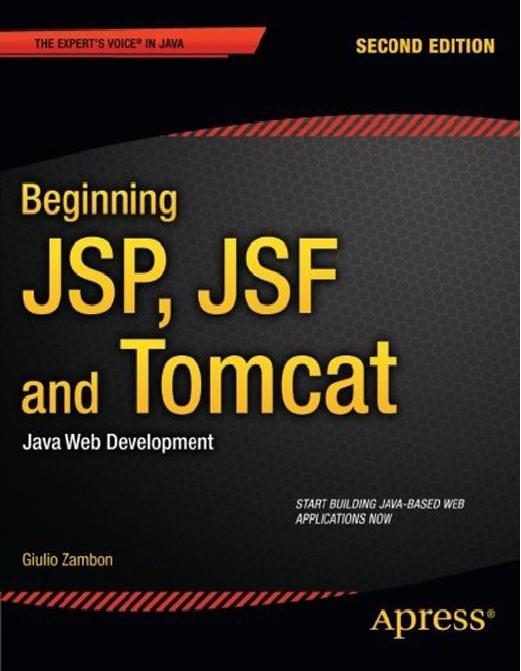Beginning JSP, JSF and Tomcat: Java Web Development by Giulio Zambon

Author:Giulio Zambon [Zambon, Giulio]
Language: eng
Format: epub, pdf
Publisher: Apress®
Published: 2011-10-07T18:30:00+00:00
// ---------- Setters
public void setChoices(Object[] cc, int kC) {
int len=0;
if (cc != null) len = cc.length;
if (len != 0) {
choices[kC].clear();
choices[kC] = new ArrayList<String>(len);
for (int k = 0; k < len; k++) {
choices[kC].add((String)cc[k]);
}
}
}
public void setChoices1(Object[] cc) { setChoices(cc, 0); }
public void setChoices2(Object[] cc) { setChoices(cc, 1); }
public void setChoices3(Object[] cc) { setChoices(cc, 2); }
public void setChoice1(String c) { choice1 = c; }
public void setChoice2(String c) { choice2 = c; }
public void setChoice3(String c) { choice3 = c; }
public void setOneValue(Object v) { oneValue = v; }
}
There isn’t really much to explain. JSF takes care of executing the initialization method of the bean, which initializes three values to be provided for selection through the select attribute and sets up the arrays needed to save the user’s choices.
Notice that I haven’t written a setter method for select. This is because I didn’t need to modify the values stored there. What you should never do is to omit the getter methods, because JSF expects to be able to read the properties.
Download
Beginning JSP, JSF and Tomcat: Java Web Development by Giulio Zambon.pdf
This site does not store any files on its server. We only index and link to content provided by other sites. Please contact the content providers to delete copyright contents if any and email us, we'll remove relevant links or contents immediately.
| Coding Theory | Localization |
| Logic | Object-Oriented Design |
| Performance Optimization | Quality Control |
| Reengineering | Robohelp |
| Software Development | Software Reuse |
| Structured Design | Testing |
| Tools | UML |
The Mikado Method by Ola Ellnestam Daniel Brolund(20604)
Hello! Python by Anthony Briggs(19900)
Secrets of the JavaScript Ninja by John Resig Bear Bibeault(18208)
Dependency Injection in .NET by Mark Seemann(18109)
The Well-Grounded Java Developer by Benjamin J. Evans Martijn Verburg(17576)
OCA Java SE 8 Programmer I Certification Guide by Mala Gupta(17422)
Kotlin in Action by Dmitry Jemerov(17185)
Adobe Camera Raw For Digital Photographers Only by Rob Sheppard(16934)
Algorithms of the Intelligent Web by Haralambos Marmanis;Dmitry Babenko(16237)
Grails in Action by Glen Smith Peter Ledbrook(15390)
Test-Driven iOS Development with Swift 4 by Dominik Hauser(10393)
Becoming a Dynamics 365 Finance and Supply Chain Solution Architect by Brent Dawson(8056)
Microservices with Go by Alexander Shuiskov(7820)
Practical Design Patterns for Java Developers by Miroslav Wengner(7721)
Test Automation Engineering Handbook by Manikandan Sambamurthy(7672)
Angular Projects - Third Edition by Aristeidis Bampakos(7160)
The Art of Crafting User Stories by The Art of Crafting User Stories(6611)
NetSuite for Consultants - Second Edition by Peter Ries(6533)
Demystifying Cryptography with OpenSSL 3.0 by Alexei Khlebnikov(6305)
